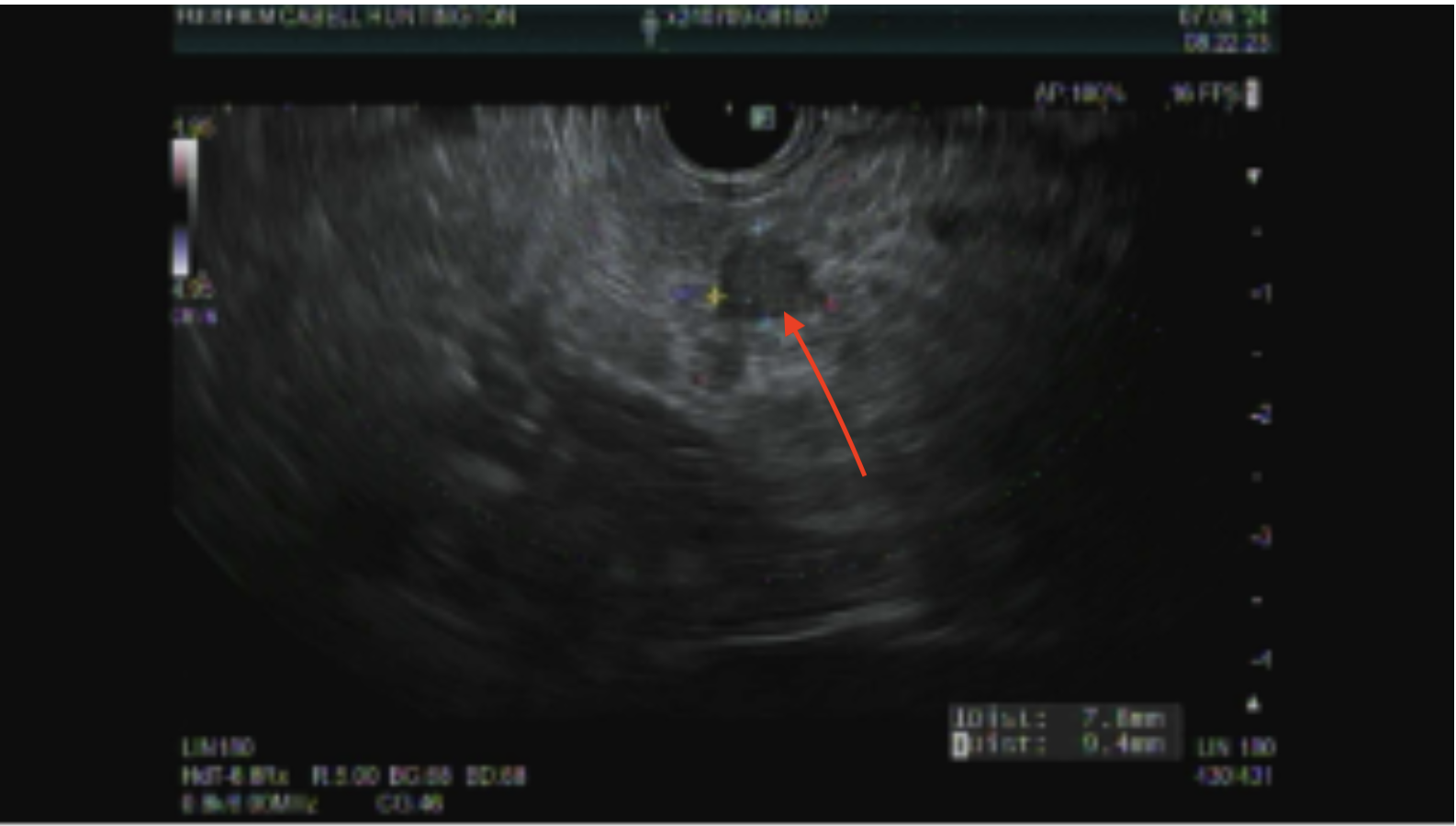Tuesday Poster Session
Category: Interventional Endoscopy
P5712 - When Common Diagnoses Overshadow the Rare: A Case Revealed by EUS After Multiple Admission
Tuesday, October 28, 2025
10:30 AM - 4:00 PM PDT
Location: Exhibit Hall

Ibrahim Shanti, MD (he/him/his)
Marshall University - - Huntington, WV
Huntington, WV
Presenting Author(s)
Ibrahim Shanti, MD1, Abdallah Hussein, MD2, Abdelwahap Elghezewi, MD3, Bassel Dakkak, MD4, Wesam Frandah, MD4, Ahmed Sherif, MD4
1Marshall University - - Huntington, WV, Huntington, WV; 2Virtua Our Lady of Lourdes Hospital, Camden, NJ; 3Marshall University Joan C. Edwards School of Medicine, Barboursville, WV; 4Marshall University Joan C. Edwards School of Medicine, Huntington, WV
Introduction: Chronic diarrhea is a common complaint with a broad differential diagnosis, often attributed to infections, medications, or inflammatory conditions. Rarely, it may signal an underlying neuroendocrine tumor such as a VIPoma—a pancreatic tumor that secretes vasoactive intestinal polypeptide and causes watery diarrhea, hypokalemia, and achlorhydria (WDHA syndrome). Due to its rarity and nonspecific presentation, VIPoma is often misdiagnosed. We present a case of a 61-year-old woman with two years of unexplained diarrhea and recurrent hypokalemia, ultimately diagnosed with a pancreatic VIPoma after extensive evaluation.
Case Description/
Methods: A 61-year-old female with a medical history of hypertension, type 2 diabetes, microscopic colitis, hyperlipidemia, and obesity presented with chronic diarrhea lasting two years. Her symptoms included frequent, clear, odorless stools, weakness, and muscle cramps. Despite multiple hospitalizations for hypokalemia and diarrhea, initially attributed to gastroenteritis, Ozempic side effects, or microscopic colitis, her condition persisted. On this admission, stool analysis was negative for pathogens, and a CT scan revealed a fluid-filled colon with pneumobilia. Gastroenterology consultation led to an endoscopic ultrasound (EUS), which identified a 9mm x 7mm mass in the uncinate process of the pancreas. A biopsy confirmed a grade 1 VIPoma, and her serum vasoactive intestinal polypeptide (VIP) levels were elevated at 280 pg/ml.
Discussion: This case emphasizes the diagnostic challenge of VIPomas in patients with chronic diarrhea and hypokalemia, particularly when more common causes have been excluded. Early identification through advanced imaging like EUS and appropriate treatment with cryoablation and octreotide led to a favorable outcome. This case underscores the need for clinicians to maintain a high index of suspicion for rare endocrine tumors in such patients, as timely diagnosis and intervention can significantly improve prognosis.

Figure: IMAGE 1: EUS showing Mass in the Uncinate process of the pancreas
Disclosures:
Ibrahim Shanti indicated no relevant financial relationships.
Abdallah Hussein indicated no relevant financial relationships.
Abdelwahap Elghezewi indicated no relevant financial relationships.
Bassel Dakkak indicated no relevant financial relationships.
Wesam Frandah: Boston Scientific – Advisor or Review Panel Member, Consultant. Merritt – Consultant. Olympus corporation of America – Consultant.
Ahmed Sherif indicated no relevant financial relationships.
Ibrahim Shanti, MD1, Abdallah Hussein, MD2, Abdelwahap Elghezewi, MD3, Bassel Dakkak, MD4, Wesam Frandah, MD4, Ahmed Sherif, MD4. P5712 - When Common Diagnoses Overshadow the Rare: A Case Revealed by EUS After Multiple Admission, ACG 2025 Annual Scientific Meeting Abstracts. Phoenix, AZ: American College of Gastroenterology.
1Marshall University - - Huntington, WV, Huntington, WV; 2Virtua Our Lady of Lourdes Hospital, Camden, NJ; 3Marshall University Joan C. Edwards School of Medicine, Barboursville, WV; 4Marshall University Joan C. Edwards School of Medicine, Huntington, WV
Introduction: Chronic diarrhea is a common complaint with a broad differential diagnosis, often attributed to infections, medications, or inflammatory conditions. Rarely, it may signal an underlying neuroendocrine tumor such as a VIPoma—a pancreatic tumor that secretes vasoactive intestinal polypeptide and causes watery diarrhea, hypokalemia, and achlorhydria (WDHA syndrome). Due to its rarity and nonspecific presentation, VIPoma is often misdiagnosed. We present a case of a 61-year-old woman with two years of unexplained diarrhea and recurrent hypokalemia, ultimately diagnosed with a pancreatic VIPoma after extensive evaluation.
Case Description/
Methods: A 61-year-old female with a medical history of hypertension, type 2 diabetes, microscopic colitis, hyperlipidemia, and obesity presented with chronic diarrhea lasting two years. Her symptoms included frequent, clear, odorless stools, weakness, and muscle cramps. Despite multiple hospitalizations for hypokalemia and diarrhea, initially attributed to gastroenteritis, Ozempic side effects, or microscopic colitis, her condition persisted. On this admission, stool analysis was negative for pathogens, and a CT scan revealed a fluid-filled colon with pneumobilia. Gastroenterology consultation led to an endoscopic ultrasound (EUS), which identified a 9mm x 7mm mass in the uncinate process of the pancreas. A biopsy confirmed a grade 1 VIPoma, and her serum vasoactive intestinal polypeptide (VIP) levels were elevated at 280 pg/ml.
Discussion: This case emphasizes the diagnostic challenge of VIPomas in patients with chronic diarrhea and hypokalemia, particularly when more common causes have been excluded. Early identification through advanced imaging like EUS and appropriate treatment with cryoablation and octreotide led to a favorable outcome. This case underscores the need for clinicians to maintain a high index of suspicion for rare endocrine tumors in such patients, as timely diagnosis and intervention can significantly improve prognosis.

Figure: IMAGE 1: EUS showing Mass in the Uncinate process of the pancreas
Disclosures:
Ibrahim Shanti indicated no relevant financial relationships.
Abdallah Hussein indicated no relevant financial relationships.
Abdelwahap Elghezewi indicated no relevant financial relationships.
Bassel Dakkak indicated no relevant financial relationships.
Wesam Frandah: Boston Scientific – Advisor or Review Panel Member, Consultant. Merritt – Consultant. Olympus corporation of America – Consultant.
Ahmed Sherif indicated no relevant financial relationships.
Ibrahim Shanti, MD1, Abdallah Hussein, MD2, Abdelwahap Elghezewi, MD3, Bassel Dakkak, MD4, Wesam Frandah, MD4, Ahmed Sherif, MD4. P5712 - When Common Diagnoses Overshadow the Rare: A Case Revealed by EUS After Multiple Admission, ACG 2025 Annual Scientific Meeting Abstracts. Phoenix, AZ: American College of Gastroenterology.
